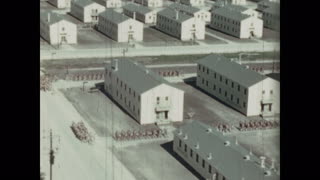Santa Fe Railway presents “Seek Strike Destroy,” a World War II-era color film made in cooperation with the US War Department’s Bureau of Public Relations and the Fort Hood military post (at the time called Camp Hood) in Texas. The film opens with a scroll supporting WWII servicemen and encourages the viewer to “redouble our resolve to speed the victory which must and will be our!” The film opens with an aerial view of Camp Hood as soldiers march in formation, prepare meals, and unload supplies from rail cars. As an incoming recruit train (mark 03:10) enters the grounds, we are introduced to a fresh-faced inductee who acts as the “guide” for the remainder of the story. Scenes from basic training unfolds as recruits march and take target practice on the gun range before beginning their advanced training (mark 05:45) as gun crews and with tank destroyers. A crew climbs aboard a tank at mark 08:00 for additional target practice followed by a run through the battle conditioning course (mark 08:40) “to accustom them to the rigors of actual combat.” After scaling walls, crawling under barbed wire, up nets, and down ropes, the recruits face a water hazard and unarmed fighting (mark 10:41). Men train with small arms, machine guns, and bazookas (mark 11:25), and learn “the art of house-to-house fighting.” Although the training is intense, the narrator explains it is necessary. “By subjecting our men to battle conditions during training, first fright is over and done with, thus enabling them to think clearly when going into actual combat,” we’re told at mark 16:26. Near mark 17:00 the film addresses some of the tactical problems of tank destroyer training, and we watch as “Nazi tanks” emerge from a tree line as part of an exercise. As training is complete, supplies and equipment are shown being loaded on freight cars and the train pulls out, “loaded with men and machines who mean business.”
During World War II, tank destroyers were developed to counter German mobile armored units. These were mobile anti-tank guns on armored halftracks or specially developed tanks. Wide-open space was needed for the tank destroyer testing and training, which Texas had in abundance. Andrew Davis (A.D.) Bruce was assigned to organize a new Tank Destroyer Tactical and Firing Center, and he chose Killeen, Texas for the new camp. The War Department announced the selection on 15 January 1942. An initial acquisition of 108,000 acres (169 mi² / 437 km²) was made, and it was estimated that the camp would cost $22,800,000 for the land, facilities, and development of utilities. The date of completion was set for 15 August 1942.
In mid-August the camp was occupied and the official opening took place on 18 September 1942. Camp Hood was named for the Confederate General John Bell Hood, who gained recognition during the Civil War as the commander of Hood’s Texas Brigade.The original facilities provided housing and training sites for nearly 38,000 troops. In January 1943, an additional 16,000 acres (65 km²) in Bell County and 34,943 acres (141 km²) in Coryell County near Gatesville, Texas were purchased. The site near Gatesville was known as the sub-camp and later as North Camp Hood. During the war years, North Camp Hood housed nearly 40,000 troops and 4,000 prisoners of war, and was the site for the southern branch of the United States Disciplinary Barracks.
At the end of 1942 there were about 45,000 troops living and training at Camp Hood and in late June 1943 it peaked at almost 95,000 troops, which was maintained until early 1944. In 1944 the number of tank destroyer battalions in training at Camp Hood declined rapidly. Field artillery battalions and the Infantry Replacement Training Center replaced them in March 1944. By September, the Infantry Center was the largest activity on post with 31,545 troops. The total camp population on the last day of 1944 was 50,228.
We encourage viewers to add comments and, especially, to provide additional information about our videos by adding a comment! See something interesting? Tell people what it is and what they can see by writing something for example: “01:00:12:00 — President Roosevelt is seen meeting with Winston Churchill at the Quebec Conference.”
This film is part of the Periscope Film LLC archive, one of the largest historic military, transportation, and aviation stock footage collections in the USA. Entirely film backed, this material is available for licensing in 24p HD, 2k and 4k. For more information visit http://www.PeriscopeFilm.com


